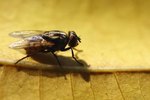
A bedbug infestation can occur quickly due to the ability of the female to produce a large number of eggs in a short period of time. The reproduction cycle of a female bedbug starts soon after hatching and lasts until she dies. This makes recognizing and treating a bedbug problem in your home extremely important.
Description
A bedbug egg is about the size of a speck of dust. Female bedbugs generally lay eggs in clusters that look like black dots on your mattress. When fully grown, the bedbug reaches about three-sixteenths of an inch. Adults are flat with a light brown hue and favor ticks or apple seeds. Bedbugs crawl instead of flying or jumping like some insects.
Environment
The temperature in their environment controls how quickly bedbugs mature. For instance, in an area where the temperature is between 70 and 80 degrees and blood for feeding is plentiful, female bedbugs may mature within a month and begin laying eggs about 32 days after hatching according to the University of Kentucky. When temperatures are lower or food is sparse, the bedbugs develop slowly and may begin laying eggs after several months. Additionally, when they mature quickly, their lifespan is often short, lasting only two to six months; when maturing slowly, they may live up to a year.
Egg Production
Females must feed to lay eggs. She produces between 3 and 12 eggs a day in the ideal environment and can produce up to 500 eggs in a lifetime. The eggs generally hatch within 7 to 12 days, and the newly hatched bug is called a nymph. The nymph looks like a beige-colored adult and turns a reddish color after feeding. After shedding its skin five times, the nymph reaches adulthood, according to the WebMD website.
Location
Females seek out dark crevices to lay their eggs where food is readily available. This makes bedding the optimal location. Signs of a bedbug infestation include dark spots and stains on mattresses that result from feces and shedding skin from the nymphs. Engorged or crushed bugs may also leave red or rust-colored smears on your bed sheets. Generally, there is no odor associated with a bedbug infestation.
References
Resources
Photo Credits
-
Jupiterimages/BananaStock/Getty Images
Writer Bio
Amanda Maddox began writing professionally in 2007. Her work appears on various websites focusing on topics about medical billing, coding, real estate, insurance, accounting and business. Maddox has her insurance and real estate licenses and holds an Associate of Applied Science in accounting and business administration from Wallace State Community College.



